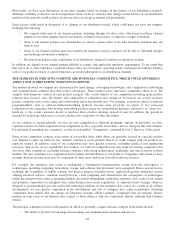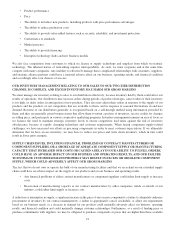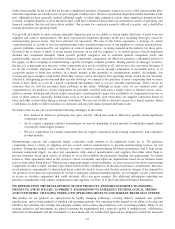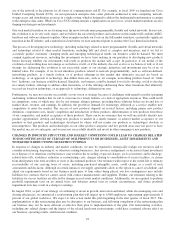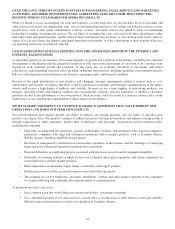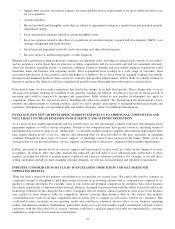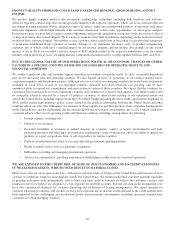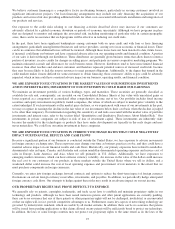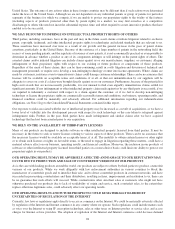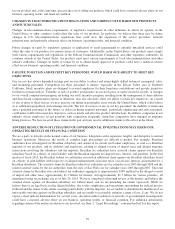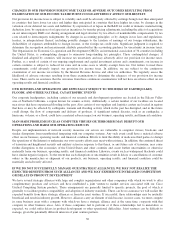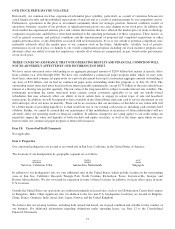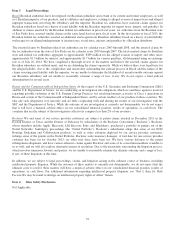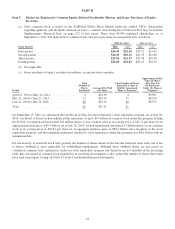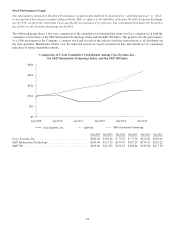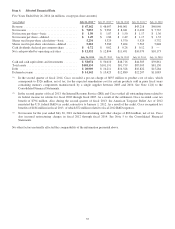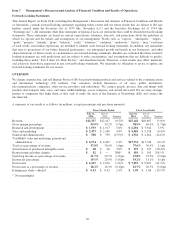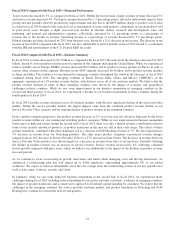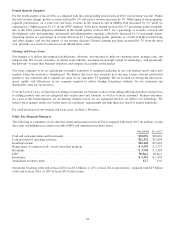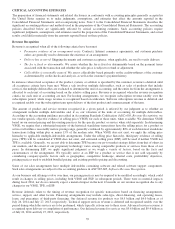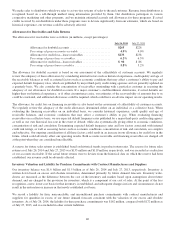Cisco 2014 Annual Report Download - page 38
Download and view the complete annual report
Please find page 38 of the 2014 Cisco annual report below. You can navigate through the pages in the report by either clicking on the pages listed below, or by using the keyword search tool below to find specific information within the annual report.CHANGES IN OUR PROVISION FOR INCOME TAXES OR ADVERSE OUTCOMES RESULTING FROM
EXAMINATION OF OUR INCOME TAX RETURNS COULD ADVERSELY AFFECT OUR RESULTS
Our provision for income taxes is subject to volatility and could be adversely affected by earnings being lower than anticipated
in countries that have lower tax rates and higher than anticipated in countries that have higher tax rates; by changes in the
valuation of our deferred tax assets and liabilities; by expiration of or lapses in the R&D tax credit or domestic manufacturing
deduction laws; by expiration of or lapses in tax incentives; by transfer pricing adjustments, including the effect of acquisitions
on our intercompany R&D cost sharing arrangement and legal structure; by tax effects of nondeductible compensation; by tax
costs related to intercompany realignments; by changes in accounting principles; or by changes in tax laws and regulations,
treaties, or interpretations thereof, including possible changes to the taxation of earnings of our foreign subsidiaries, the
deductibility of expenses attributable to foreign income, or the foreign tax credit rules. Significant judgment is required to
determine the recognition and measurement attribute prescribed in the accounting guidance for uncertainty in income taxes.
The Organisation for Economic Co-operation and Development (OECD), an international association of 34 countries including
the United States, is contemplating changes to numerous long-standing tax principles. These contemplated changes, if
finalized and adopted by countries, will increase tax uncertainty and may adversely affect our provision for income taxes.
Further, as a result of certain of our ongoing employment and capital investment actions and commitments, our income in
certain countries is subject to reduced tax rates and in some cases is wholly exempt from tax. Our failure to meet these
commitments could adversely impact our provision for income taxes. In addition, we are subject to the continuous
examination of our income tax returns by the Internal Revenue Service and other tax authorities. We regularly assess the
likelihood of adverse outcomes resulting from these examinations to determine the adequacy of our provision for income
taxes. There can be no assurance that the outcomes from these continuous examinations will not have an adverse effect on our
operating results and financial condition.
OUR BUSINESS AND OPERATIONS ARE ESPECIALLY SUBJECT TO THE RISKS OF EARTHQUAKES,
FLOODS, AND OTHER NATURAL CATASTROPHIC EVENTS
Our corporate headquarters, including certain of our research and development operations are located in the Silicon Valley
area of Northern California, a region known for seismic activity. Additionally, a certain number of our facilities are located
near rivers that have experienced flooding in the past. Also certain of our suppliers and logistics centers are located in regions
that have or may be affected by earthquake, tsunami and flooding activity which in the past has disrupted, and in the future
could disrupt, the flow of components and delivery of products. A significant natural disaster, such as an earthquake, a
hurricane, volcano, or a flood, could have a material adverse impact on our business, operating results, and financial condition.
MAN-MADE PROBLEMS SUCH AS COMPUTER VIRUSES OR TERRORISM MAY DISRUPT OUR
OPERATIONS AND HARM OUR OPERATING RESULTS
Despite our implementation of network security measures our servers are vulnerable to computer viruses, break-ins, and
similar disruptions from unauthorized tampering with our computer systems. Any such event could have a material adverse
effect on our business, operating results, and financial condition. Efforts to limit the ability of malicious third parties to disrupt
the operations of the Internet or undermine our own security efforts may meet with resistance. In addition, the continued threat
of terrorism and heightened security and military action in response to this threat, or any future acts of terrorism, may cause
further disruptions to the economies of the United States and other countries and create further uncertainties or otherwise
materially harm our business, operating results, and financial condition. Likewise, events such as widespread blackouts could
have similar negative impacts. To the extent that such disruptions or uncertainties result in delays or cancellations of customer
orders or the manufacture or shipment of our products, our business, operating results, and financial condition could be
materially and adversely affected.
IF WE DO NOT SUCCESSFULLY MANAGE OUR STRATEGIC ALLIANCES, WE MAY NOT REALIZE THE
EXPECTED BENEFITS FROM SUCH ALLIANCES AND WE MAY EXPERIENCE INCREASED COMPETITION
OR DELAYS IN PRODUCT DEVELOPMENT
We have several strategic alliances with large and complex organizations and other companies with which we work to offer
complementary products and services and have established a joint venture to market services associated with our Cisco
Unified Computing System products. These arrangements are generally limited to specific projects, the goal of which is
generally to facilitate product compatibility and adoption of industry standards. There can be no assurance we will realize the
expected benefits from these strategic alliances or from the joint venture. If successful, these relationships may be mutually
beneficial and result in industry growth. However, alliances carry an element of risk because, in most cases, we must compete
in some business areas with a company with which we have a strategic alliance and, at the same time, cooperate with that
company in other business areas. Also, if these companies fail to perform or if these relationships fail to materialize as
expected, we could suffer delays in product development or other operational difficulties. Joint ventures can be difficult to
manage, given the potentially different interests of joint venture partners.
30


